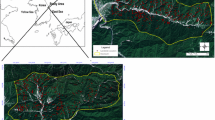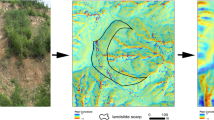Abstract
To improve landslide hazard mapping quality, a functional relationship with travel distance prediction is essential. To obtain a more accurate empirical relationship for predicting loess slide travel distances, we developed a loess slide database for the central Loess Plateau using a combination of remote sensing image interpretations, existing datasets, and an intensive field survey. The loess slide travel distance was concentrated within less than 200 m, according to a cumulative frequency analysis. Our results reveal that the loess slide volume, slope height, and slope inclination of the sliding area control the travel distance, and this relation is well-described by a power law function. Furthermore, statistical analysis suggested that the equivalent coefficient of friction decreases with an increase in loess slide volume but increases with an increase in slope inclination. We compared the prediction performances of four empirical relationships proposed in this study using the mean absolute percentage error and Theil inequality coefficient methods. We discovered that the empirical relationship with three independent variables can more accurately predict the loess slide travel distance than the relationships with one or two independent variables.









Similar content being viewed by others
References
Armstrong JS, Collopy F (1992) Error measures for generalizing about forecasting methods: empirical comparisons. Int J Forecast 8(1):69–80
Budetta P, De Riso R (2004) The mobility of some debris flows in pyroclastic deposits of the northwestern Campanian region (southern Italy). Bull Eng Geol Environ 63(4):293–302
Bagnold RA (1954) Experiments on a gravity-free dispersion of large solid spheres in a Newtonian fluid under shear. Proc R Soc A 225(1160):49–63
Corominas J (1996) The angle of reach as a mobility index for small and large landslides. Can Geotech J 33(2):260–271
Crosta GB, Imposimato S, Roddeman DG (2003) Numerical modelling of large landslides stability and runout. Nat Hazards Earth Syst Sci 3(6):523–538
Cui Y, Zhou X, Guo C (2017a) Experimental study on the moving characteristics of fine grains in wide grading unconsolidated soil under heavy rainfall. J Mt Sci 14(3):417–431
Cui Y, Chan D, Nouri A (2017b) Coupling of solid deformation and pore pressure for undrained deformation—a discrete element method approach. Int J Numer Anal Methods Geomech 41(18):1943–1961
Cui Y, Chan D, Nouri A (2017c) Discontinuum modelling of solid deformation pore water diffusion coupling. Int J Geomech (ASCE) 17(8):04017033
Chen H, Lee CF (2003) A dynamic model for rainfall-induced landslides on natural slopes. Geomorphology 51(4):269–288
Chen HX, Zhang LM, Zhang S, Xiang B, Wang XF (2013) Hybrid simulation of the initiation and runout characteristics of a catastrophic debris flow. J Mt Sci 10(2):219–232
Chen HX, Zhang LM, Gao L, Zhu H, Zhang S (2015) Presenting regional shallow landslide movement on three-dimensional digital terrain. Eng Geol 195:122–134
Davies TR (1982) Spreading of rock avalanche debris by mechanical fluidization. Rock Mech 15(1):9–24
Davis, P.A., Goodrich, M.T., 1990. A proposed strategy for the validation of ground-water flow and solute transport models. Technical Report, Sandia National Labs., Albuquerque, NM (USA)
Derbyshire E, Wang J, Jin Z et al (1991) Landslides in the Gansu loess of China. Catena Suppl 20:119–145
Derbyshire E, Van Asch T, Billard A et al (1995) Modelling the erosional susceptibility of landslide catchments in thick loess: Chinese variations on a theme by Jan de Ploey. Catena 25:315–331
Derbyshire E (2001) Geological hazards in loess terrain, with particular reference to the loess regions of China. Earth Sci Rev 54(1):231–260
Devoli G, De Blasio FV, Elverhøi A, Høeg K (2009) Statistical analysis of landslide events in central America and their run-out distance. Geotech Geol Eng 27(1):23–42
Dijkstra TA, Wasowski J, Winter MG, Meng XM (2014) Introduction to geohazards of Central China. Q J Eng Geol Hydrogeol 47(3):195–199
Finlay PJ, Mostyn GR, Fell R (1999) Landslide risk assessment: prediction of travel distance. Can Geotech J 36(3):556–562
Frattini P, Crosta G, Carrara A (2010) Techniques for evaluating the performance of landslide susceptibility models. Eng Geol 111(1):62–72
Frechen M, Oches EA, Kohfeld KE (2003) Loess in Europe—mass accumulation rates during the last glacial period. Quat Sci Rev 22(18):1835–1857
Guo D, Hamada M, He C, Wang Y, Zou Y (2014) An empirical model for landslide travel distance prediction in Wenchuan earthquake area. Landslides 11(2):281–291
Guo XJ, Cui P, Li Y (2013) Debris flow warning threshold based on antecedent rainfall: a case study in Jiangjia Ravine, Yunnan, China. J Mt Sci 10(2):305–314
Hattanji T, Moriwaki H (2009) Morphometric analysis of relic landslides using detailed landslide distribution maps: implications for forecasting travel distance of future landslides. Geomorphology 103(3):447–454
Hungr O, Morgan G, Kellerhals R (1984) Quantitative analysis of debris torrent hazards for design of remedial measures. Can Geotech J 21(4):663–677
Hungr O (1995) Amodel for the movement analysis of rapid flow slides, debris flows, and avalanches. Can Geotech J 32(4):610–623
Huang Y, Zhang W, Xu Q, Xie P, Hao L (2012) Run-out analysis of flow-like landslides triggered by the Ms 8.0 2008Wenchuan earthquake using smoothed particle hydrodynamics. Landslides 9(2):275–283
Heim A (1932) Bergsturz und Menschenleben. Fretz und Wasmuth, Zurich, p 218
Hayashi JN, Self S (1992) A comparison of pyroclastic flow and debris avalanche mobility. J Geophys Res Solid Earth 97(B6):9063–9071
Hunter G, Fell R (2003) Travel distance angle for “rapid” landslides in constructed and natural soil slopes. Can Geotech J 40(6):1123–1141
Howard KA (1973) Avalanche mode of motion. Implications from lunar examples. Science 180:1052–1054
Hsü KJ (1975) Catastrophic debris streams (Sturzstroms) generated by rockfalls. Geol Soc Am Bull 86:129–140
Kang C, Chan D (2017) Modelling of entrainment in debris flow analysis for dry granular material. Int J Geomech (ASCE) 17(10):1–20
Legros F (2002) The mobility of long-runout landslides. Eng Geol 63(3):301–331
Leuthold RM (1975) On the use of Theil's inequality coefficients. Am J Agric Econ 57(2):344–346
Liu TS (1985) Loess and environment. China Ocean Press, Beijing
McKinnon M (2010) Landslide runout: statistical analysis of physical characteristics and model parameters. University of British Columbia
Okura Y, Kitahara H, Sammori T, Kawanami A (2000) The effects of rockfall volume on travel distance. Eng Geol 58:109–124
Okura Y, Kitahara H, Kawanami A, Kurokawa U (2003) Topography and volume effects on travel distance of surface failure. Eng Geol 67(3):243–254
O’Brien JS, Julien PY, Fullerton WT (1993) Two-dimensional water flood and mudflow simulation. J Hydraul Eng 119:244–261
Pastor M, Haddad B, Sorbino G, Cuomo S, Drempetic V (2009) A depth-integrated, coupled SPH model for flow-like landslides and related phenomena. Int J NumerAnal Methods Geomech 33(2):143–172
Qiu H, Regmi AD, Cui P, Cao M, Lee J, Zhu X (2016) Size distribution of loess slides in relation to local slope height within different slope morphologies. CATENA 145:155–163
Qiu H, Cui P, Regmi AD et al (2017) Slope height and slope gradient controls on the loess slide size within different slip surfaces. Phys Geogr 38(4):303–317
Qiu H, Cui P, Regmi AD et al (2018) The effects of slope length and slope gradient on the size distributions of loess slides: field observations and simulations. Geomorphology 300:69–76
Rickenmann D (1999) Empirical relationships for debris flows. Nat Hazards 19(1):47–77
Scheidegger AE (1973) On the prediction of the reach and velocity of catastrophic landslides. Rock Mech 5(4):231–236
Sassa K (1988) Geotechnical model for the motion of landslides (special lecture). Proceedings of the 5th International Symposium on Landslides. Lausanne:37–56
Sassa K, Fukuoka H, Wang F, Wang GH (2005) Dynamic properties of earthquake-induced large-scale rapid landslides within past landslide masses. Landslides 2:125–134
Shi JS, Wu LZ, Wu SR, Li B, Wang T, Xin P (2016) Analysis of the causes of large-scale loess landslides in Baoji, China. Geomorphology 264:109–117
Shreve RL (1966) Sherman landslide, Alaska. Science 154:1639–1643
Theil H (1966) Applied economic forecasting. Rand-McNally & Co., Chicago
Tang C, Zhu J, Chang M, Ding J, Qi X (2012) An empirical-statistical model for predicting debris-flow runout zones in the Wenchuan earthquake area. Quat Int 250:63–73
Takahashi T (1991) Debris flow. Balkema, Rotterdam
Ui T (1983) Volcanic dry avalanche deposits—identification and comparison with nonvolcanic debris stream deposits. J Volcanol Geotherm Res 18(1):135–150
Varnes DJ (1978) Slope movement types and processes. In: Schuster RL, Krizck RJ (eds) Landslides; analysis and control, special report, vol. 176. Transportation Research Board. National Academy of Sciences, Washington, DC, pp 11–33
Xu L, Dai FC, Tham LG, Zhou YF, Wu CX (2012) Investigating landslide-related cracks along the edge of two loess platforms in Northwest China. Earth Surf Process Landf 37(10):1023–1033
Yang C, Zhang J, Zhang M (2013) A prediction model for horizontal run-out distance of landslides triggered by Wenchuan earthquake. Earthq Eng Eng Vib 12(2):201–208
Zhan W, Fan X, Huang R et al (2017) Empirical prediction for travel distance of channelized rock avalanches in the Wenchuan earthquake area. Nat Hazards Earth Syst Sci 17(6):833
Zhang MS, Liu J (2010) Controlling factors of loess landslides in western China. Environ Earth Sci 59(8):1671–1680
Zhang F, Pei X, Chen W, Liu G, Liang S (2014) Spatial variation in geotechnical properties and topographic attributes on the different types of shallow landslides in a loess catchment, China. Eur J Environ Civil Eng 18(4):470–488
Zhang F, Kang C, Chan D, Zhang X, Pei X, Peng J (2017) A study of a flowslide with significant entrainment in loess areas in China. Earth Surf Process Landf 42(14):2295–2305
Zou Z, Xiong C, Tang H et al (2017) Prediction of landslide runout based on influencing factor analysis. Environ Earth Sci 76(21):723
Funding
This work was funded by the National Natural Science Foundation of China (Grant No. 41771539) and International Partnership Program of Chinese Academy of Sciences (Grant no. 131551KYSB20160002).
Author information
Authors and Affiliations
Corresponding author
Rights and permissions
About this article
Cite this article
Qiu, H., Cui, P., Hu, S. et al. Developing empirical relationships to predict loess slide travel distances: a case study on the Loess Plateau in China. Bull Eng Geol Environ 77, 1299–1309 (2018). https://doi.org/10.1007/s10064-018-1328-0
Received:
Accepted:
Published:
Issue Date:
DOI: https://doi.org/10.1007/s10064-018-1328-0




